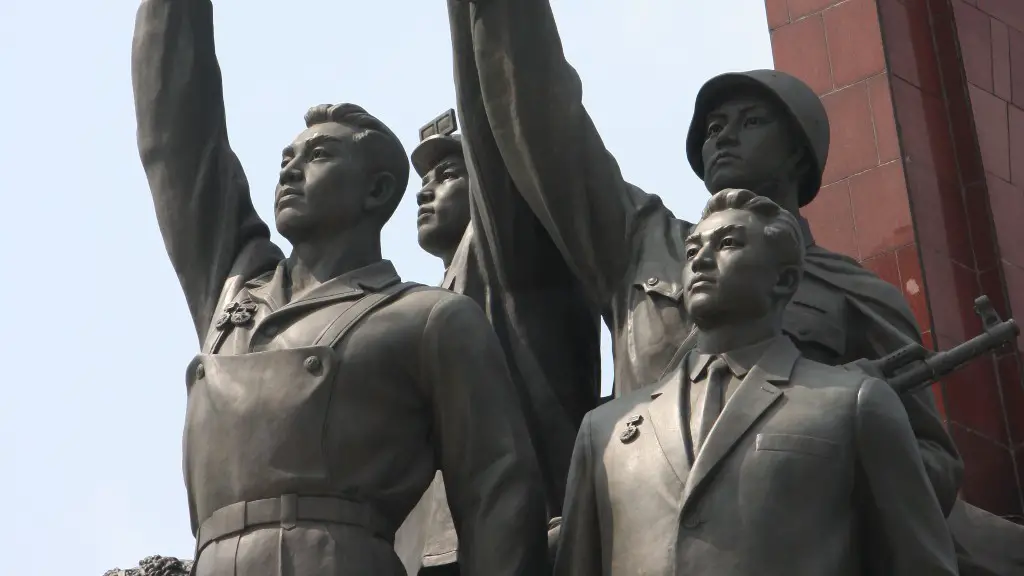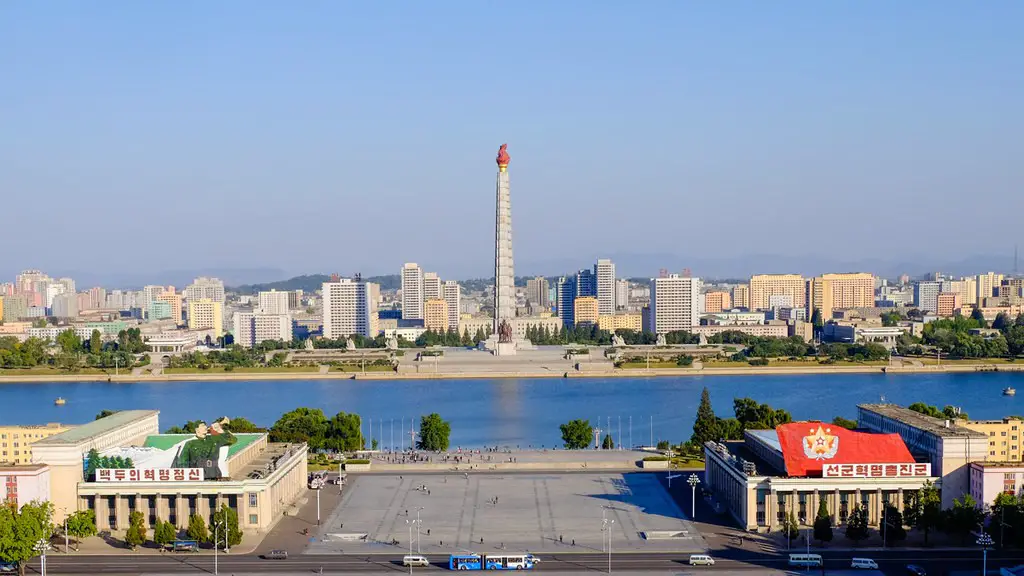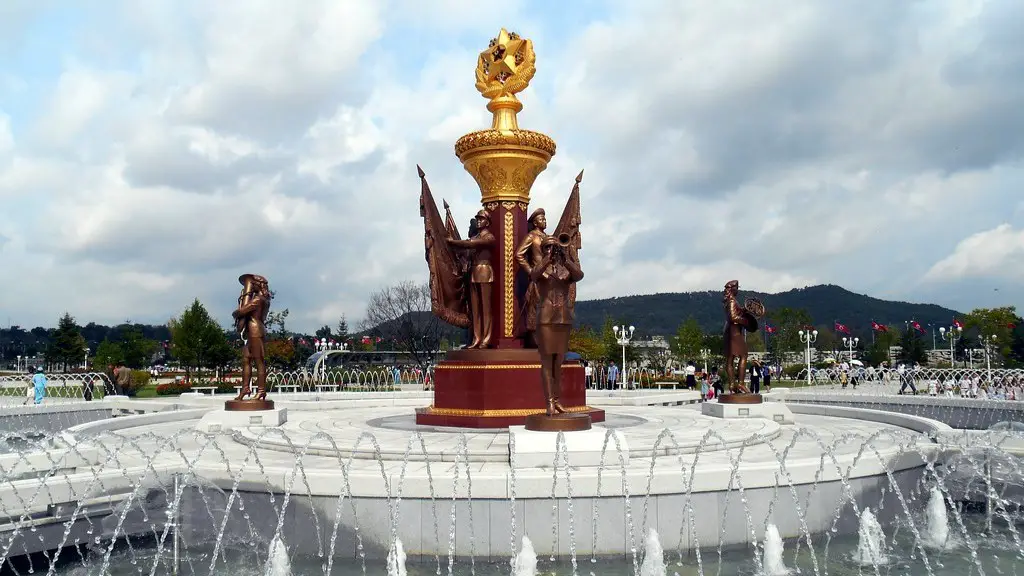Why Is North Korea and South Korea Divided?
The two nations of North and South Korea were originally an independent entity until the end of World War II. At this point, Korea was divided into two countries, with the North becoming a Soviet satellite state, while the South fell into the American sphere of influence. The division ultimately led to the outbreak of the Korean War in 1950, however, a peace treaty was never signed and both countries have remained in a kind of military stand-off ever since.
The division is rooted in the differences between the pro-democratic South and the more authoritarian North. North Korea heavily relies on a single party system of rule, backed by a huge army and an isolationist foreign policy. South Korea, on the other hand, is a vibrant democracy with active engagement in the global economy. This sharp contradistinction in outlook between the two countries has meant that they have found it hard to bridge the political divide, leading to decades of tension.
The economic gap has been the other great source of division between North and South Korea. South Korea has managed to develop a strong and thriving economy fuelled by technology exports, while North Korea has been largely cut off from the international community with its own heavily subsidized economy, reliant on its limited resources. This rendered the North vulnerable in times of external crises and sanctions, causing immense hardship for the population and leaving them at the mercy of political winds.
The division between North and South has been exacerbated by the Hermit Kingdom’s aggressive nuclear activity. North Korea’s nuclear weapons appear to have been a response to the desire of the ruling Kim family for a strong and independent state, one that is able to stand up to the Western hegemony. Though most of the world has encouraged a peaceful resolution to the conflict, recent history has shown that North Korea’s nuclear arsenal has likely made a true resolution even more difficult to achieve.
The history of strife is deep between the two nations, and that is unlikely to come to an end any time soon. Both sides are focused on maintaining their political ideologies and remain averse to any potential compromise. Despite some positive movements in recent years, most notably the 2018 Summit between North Korean leader Kim Jong Un and South Korean President Moon Jae-in, divisions between the two countries continue to be deep and are unlikely to be resolved soon.
Military Standoff
Given the ongoing military standoff between North and South Korea, it is unlikely that either side is willing to make concessions. Despite occasional offers of peace and potential reunification, the North has always insisted on retaining its nuclear weapons and isolated political system, while the South has maintained the long-held view that it cannot agree to the North’s nuclear threats. With neither side willing to budge, hopes of reunification appear to be diminishing.
The military stand-off has resulted in a build-up of armaments and troops on both sides of the border. Both nations have been investing heavily in their military strength, with the South largely favouring traditional military hardware while the North has developed a vast arsenal of missiles and other weapons of mass destruction.
The South Korean government has also undertaken significant steps to strengthen its presence in the region, including developing a missile shield and negotiating a closer relationship with the United States. This has triggered a major military build-up North Korea, as the Kim regime looks to counter the threat posed by a much better equipped South Korea.
The military tensions have been a major roadblock to any resolution of the conflict, and given the level of mistrust between the two sides, it appears unlikely that a peaceful reconciliation can be achieved in the near future.
Implications For The Global Community
The ongoing tensions have also had implications for the wider global community. The unresolved conflict has meant that both sides remain on a perpetual war footing, representing a significant threat to global security. Although no significant military conflict has arisen since the end of the Korean War, both sides have engaged in periodic skirmishes, the most recent being the landmine incident in 2015.
The issue is further complicated by the potential for international collusion. The United States, for instance, is keen to maintain its strategic position in the region and could potentially take action on North Korea in order to further this goal. At the same time, China remains wary of any action that could provoke North Korea and put its vital shipping lanes at risk. As such, the resolution of the conflict appears to hinge on the opinion of the major international players.
The conflict also has significant economic implications, particularly for South Korea, which is heavily reliant on exports. South Korean businesses are vulnerable to any disruption in their trading relationships, which could be caused by any instability in the region, further exasperating an already difficult situation.
The conflict also has deep emotional and psychological implications. Since the division of the two countries, families have been separated, relationships severed, and an entire generation has grown up without ever having visited their relatives on the other side of the border. The emotional impact of the division has been vast and it appears unlikely that the wounds of separation will be healed any time soon.
Korean Reunification Prospects
The prospects for the reunification of North and South Korea appear bleak at present. Both sides remain entrenched in their respective political ideologies and have no apparent desire to compromise. The South has generally supported a reunification based on a peaceful resolution, although recent political developments make this a distant prospect.
The North, meanwhile, is adamant that any reunification must acknowledge its nuclear arsenal, with the Kim regime likely viewing its nuclear programme as key to its continued independence. This has been met with fierce resistance from the South, and while negotiations have been attempted in the past, they have generally failed to bring the two sides any closer to a resolution.
Recent political shifts have also made reunification efforts more difficult. With the South electing a President who shares many of the same right-wing political views as Donald Trump and the North intensifying its aggression, the possibility of meaningful progress appears increasingly remote.
The issue of reunification of North and South Korea remains as contentious as ever and is unlikely to be resolved in the near future. Unless both sides can find a way to bridge their ideological differences and reach a compromise on the issue of North Korea’s nuclear programme, the two countries are likely to remain divided for the foreseeable future.
Public Opinion Of Reunification
The current public opinion of potential reunification among both North and South Koreans varies widely. Despite the dire current circumstances, many South Koreans still view the possibility of reunification as something to be desired and actively strive for, in order to reunite long separated families and create a more united Korean identity.
Opinion in the North is harder to gauge, but it appears likely that the ruling Kim dynasty is keen to maintain its hold on power and is likely to resist any attempts at reunification that could threaten this. There are signs that public opinion is slowly shifting, however, with younger generations slowly beginning to question the long held dogma of their government.
Resolutions to the conflict are also complicated by the lack of consensus among the international community. The US has been generally firm in its position of preventing the North from developing nuclear weapons, however, China and Russia have both shown more willingness to accept the North as it is. This is complicating the process of finding a diplomatic solution that could potentially reunite North and South Korea.
The reunification of North and South Korea remains a distant prospect, with the two sides showing no signs of finding any common ground. Given the deep political divide and lack of consensus among the international community, there appears to be little hope of a reunification on the horizon.
Conclusion
The relationship between North and South Korea remains strained, and while there have been some recent developments, most notably the 2018 summit between President Moon Jae-in and Kim Jong-Un, the possibility of a full reunification appears bleak at best. The two countries remain worlds apart in terms of ideology, economy and nuclear armament, making the resolution of the long-running conflict extremely challenging.
Furthermore, the current international climate further complicates the situation, with the opinions of the major players diverging widely. At present, it appears likely that the stalemate between North and South Korea is set to continue for the foreseeable future, with the possibility of a peaceful reunification appearing more and more distant.





